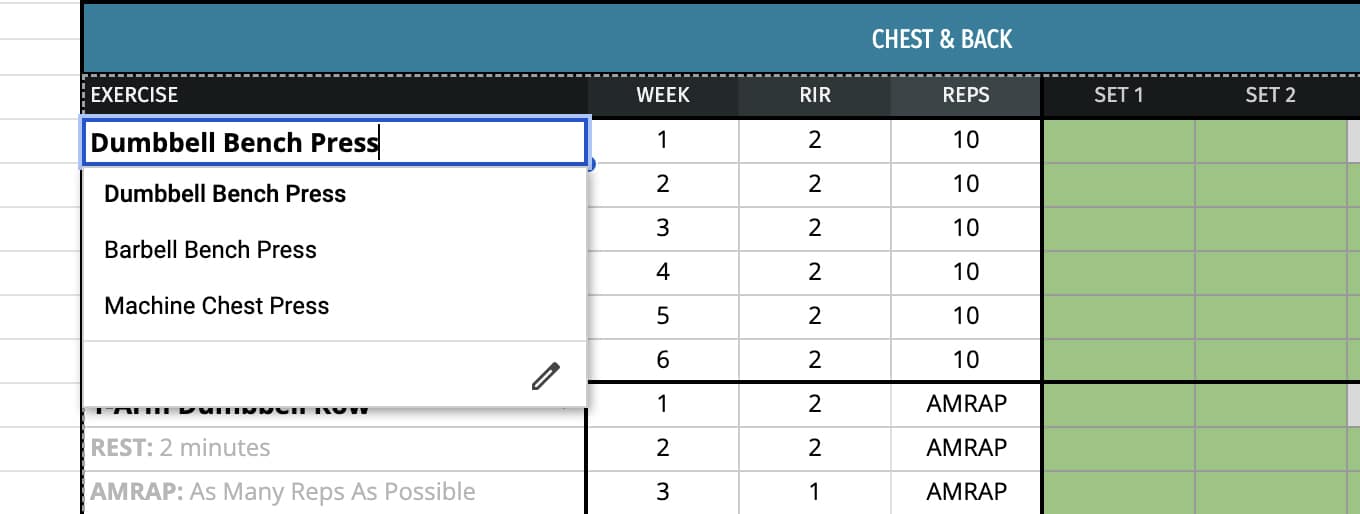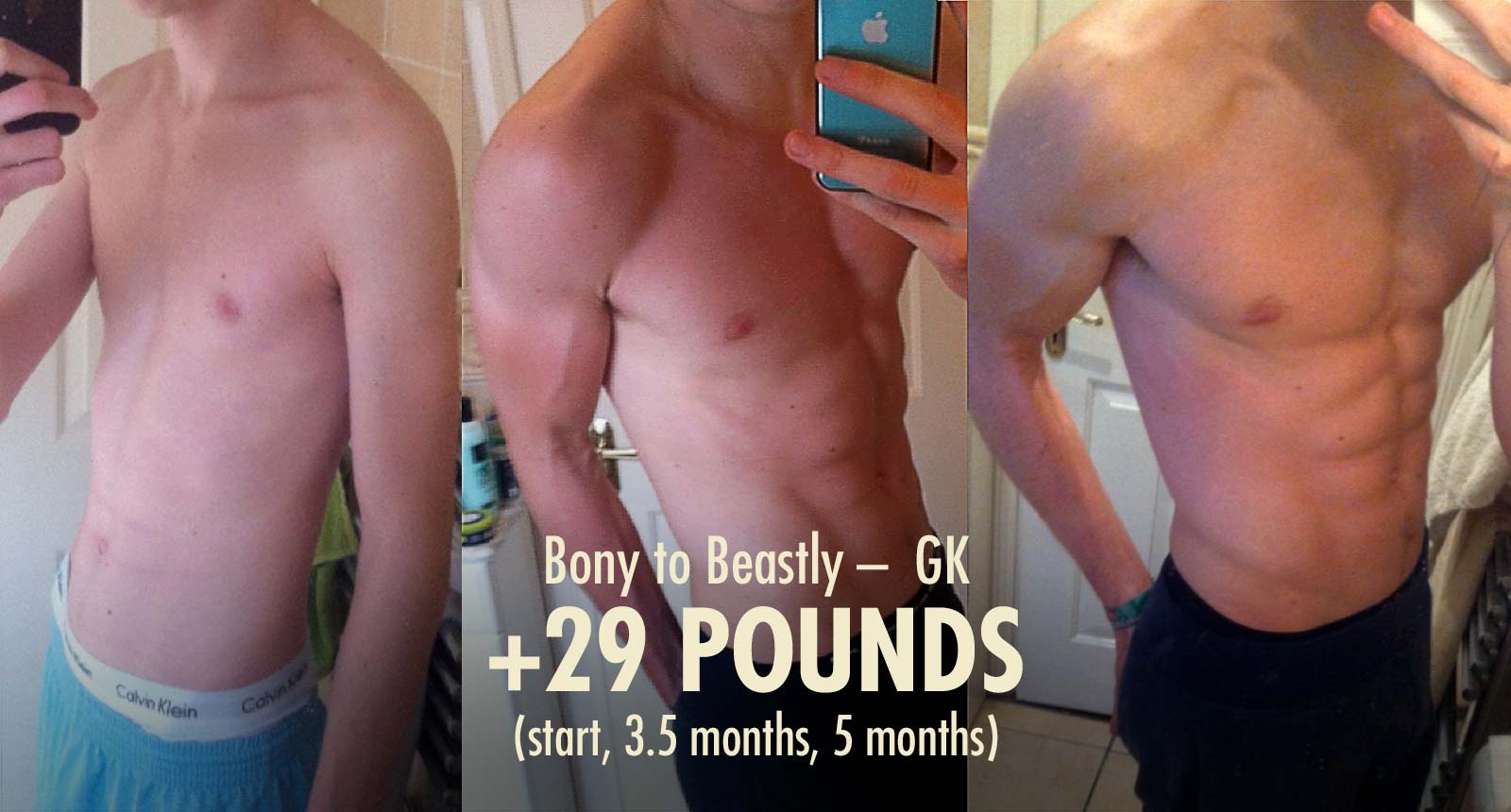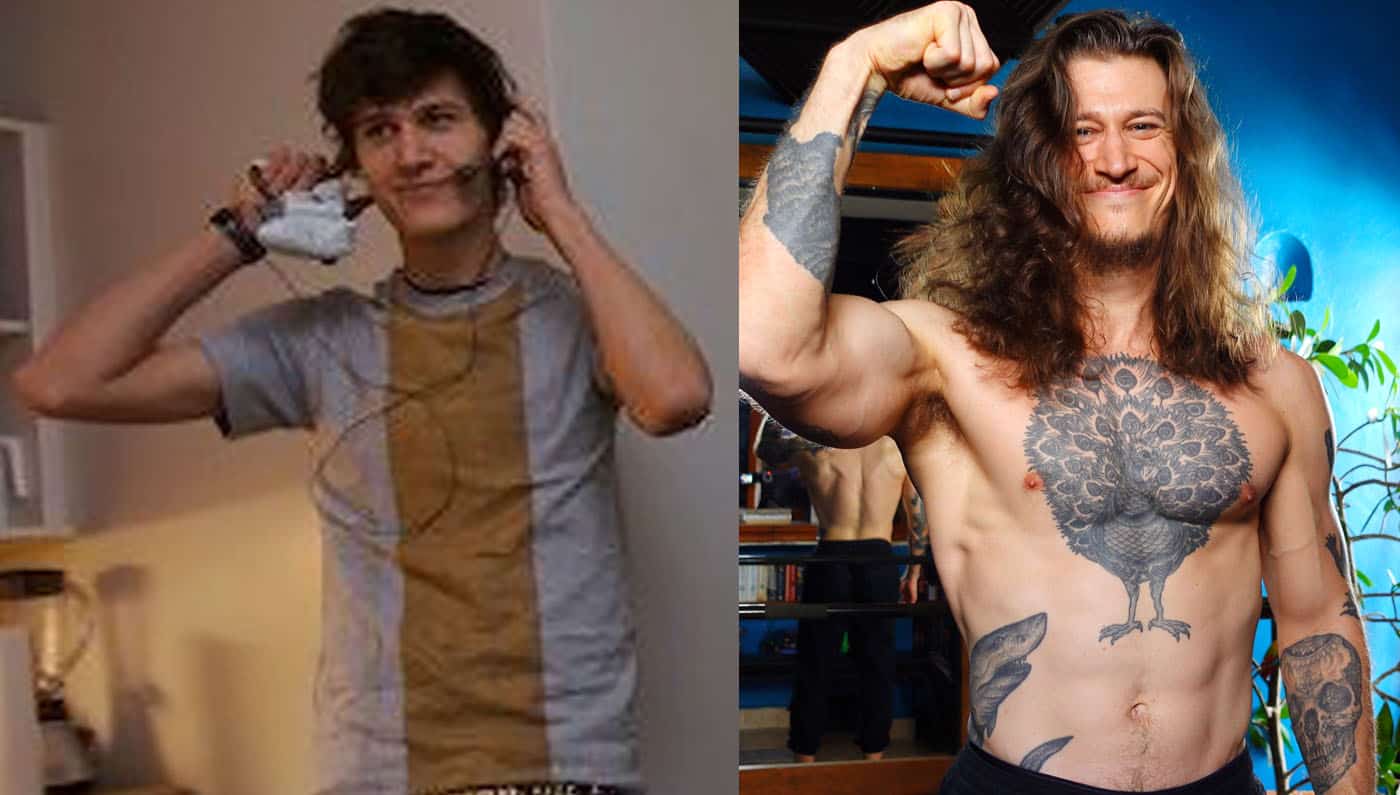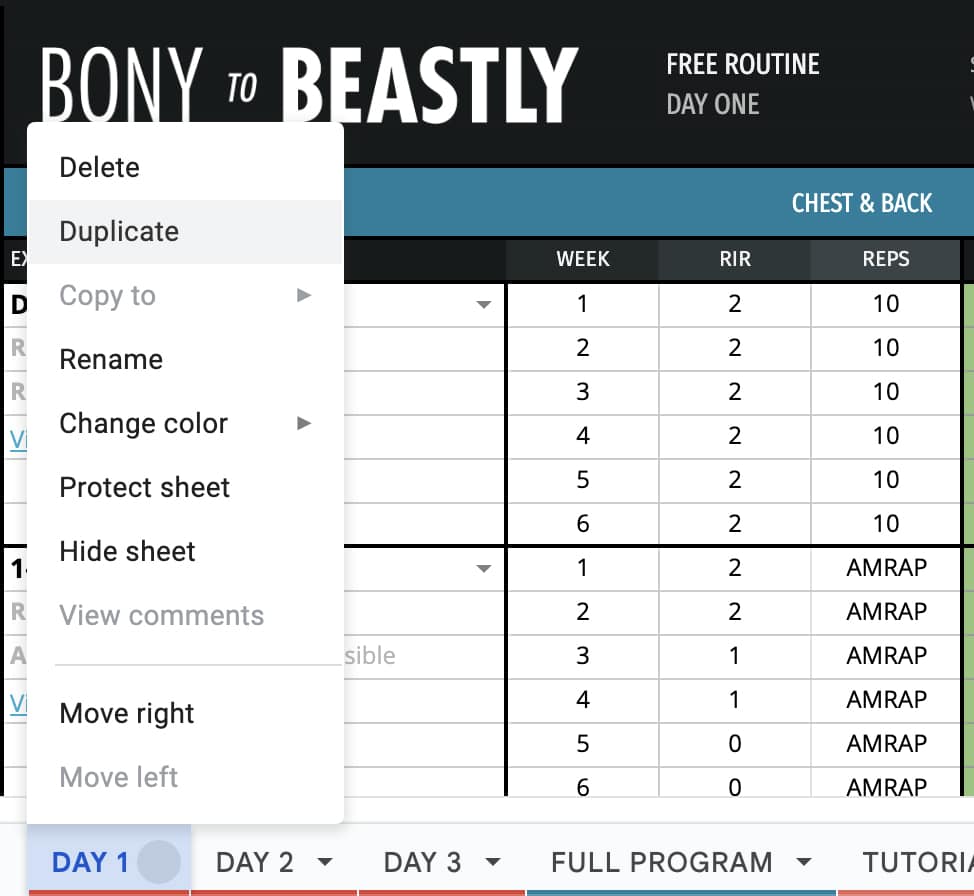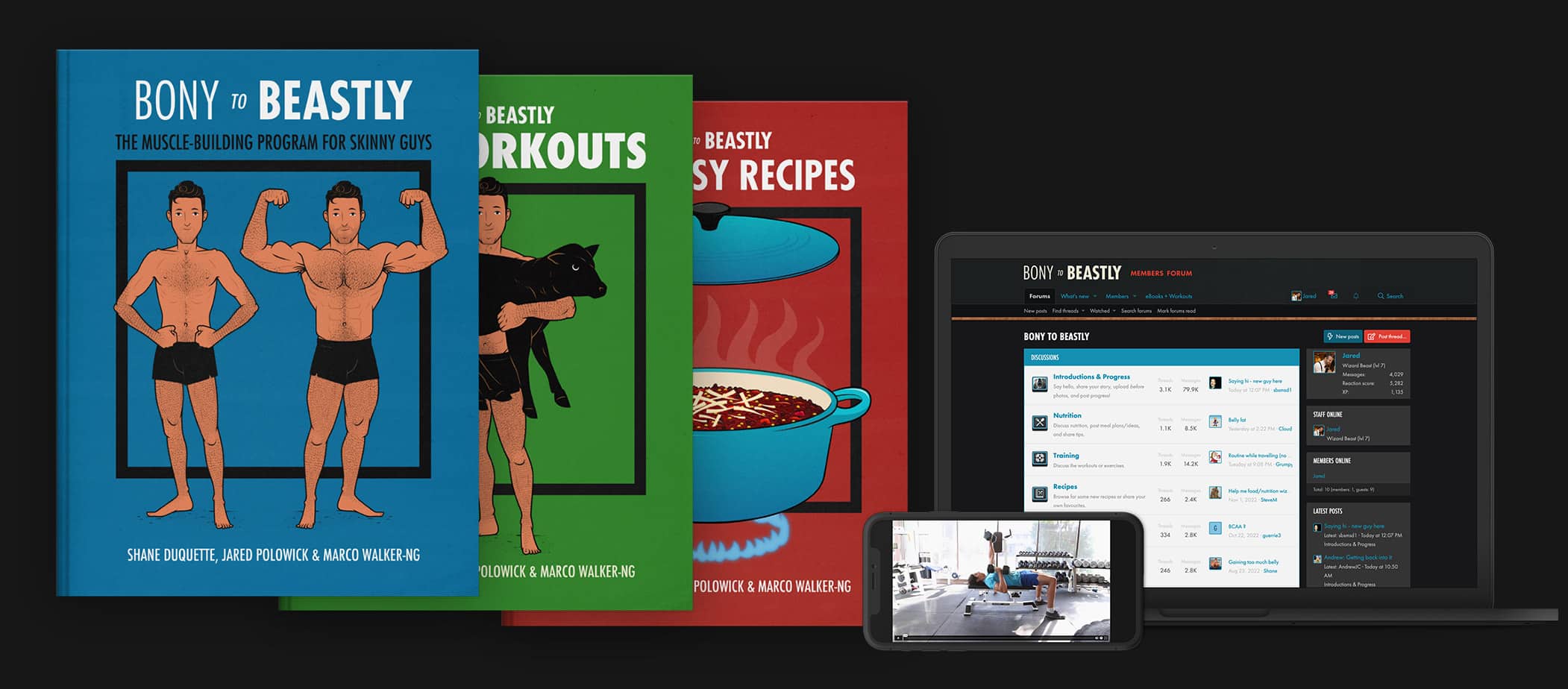get the google spreadsheet of the
free beginner’s full-body workout
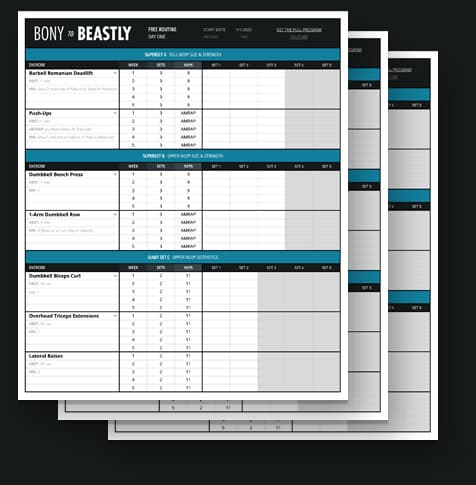
Get the workout as a Google spreadsheet. You’ll be able to pick from exercise alternatives, fill out the sheet, and get our beginner’s warm-up.
Plus, we’ll make sure you’re on the b2B newsletter, and send you all of our best muscle-building content.
How to Edit the Workout Sheets
If you're filling in the workout sheets on a desktop, you can open them up in your internet browser. If you're using them on your phone or tablet, I recommend getting the Google Sheets app. It's free.
To edit the sheets, go to File and select "Make a Copy." On mobile, File is usually "…". That will give you your own personal copy.
Once you have your own copy of the spreadsheet, it's completely yours. We can't see or control what you do with it, and we can't take it back. You can change it however you like. It's totally yours forever.
You can do the full workout program with adjustable dumbbells, a barbell home gym, or a gym membership.
The first step is to choose your exercise variations from the dropdown menus. We gave you a few variations for each exercise, each with a tutorial video. There's always at least one dumbbell option, barbell option, and exercise machine option.
If you don't like any of those options, write in your own. You can customize the sheets as much as you like. Don't worry about breaking anything. You can always make a new copy from the original template.
If you want ideas for what exercises to do, the last tab in the workout sheet has 150 exercise tutorial videos. If you write in the name of one of those exercises, the workout sheet will automatically link to that tutorial video.
3-Day Full-Body Workout Routine
There are three workouts per week, each with its own tab in the spreadsheet. Each workout is slightly different, but each trains most of the muscles in your body.
Full-body workout routines are (debatably, I know) better than split routines because they train each of your muscles 2–3x per week, keeping them growing all week long. This advantage is fairly modest, though.
Full-body routines are especially good for beginners because you'll be getting plenty of practice squatting, benching, deadlifting, rowing, and doing vertical pulls (like pulldowns and pull-ups). Practicing these big exercises more frequently makes it easier to get good at them. You'll get better as a lifter faster.
Full-body routines are also tremendously efficient. Whatever your favourite exercise is, you're doing it three times per week, getting more of what it has to offer. If the bench press is your favourite chest exercise, you're doing it three times per week, getting all of its advantages more often (including getting stronger faster).
How to Record Your Workouts
Your quest is to fill in all of the green boxes. When you fill them in, the vibrant green colour will transfuse from the sheet into your soul, leaving the cell white. It will take you five weeks of working out three times per week to fill in the entire sheet, at which point you'll have soaked up all of the sheet's energy, leaving it a pristine and lifeless white.
You can fill in the boxes however you like, but I recommend writing weight × reps, like this:
You're supposed to fill in the rows week by week. In the first week, you fill in the row for "Week 1." Next week, you fill in "Week 2," trying to lift more weight or get more reps than last time:
We have the weeks right next to each other to make it easy to see what numbers you're trying to beat. We want you thinking about progressive overload.
There are two ways to progressively overload your exercises. Most beginners like to lift conservatively, stopping at 10 reps in earlier sets until they get 10 reps in all sets. Then they add a little bit of weight next week. It's simple and works great. It keeps the earlier sets easier and the later sets harder. Great for building muscle.
Another option is to push hard on every set. Maybe that means getting 13 reps in the first set, 9 in the second, and 7 in the third. Again, you'd stick with the same weight until you get 10 reps in all of your sets. But this time, you're pushing closer to failure in earlier sets, getting more tired, and hemorrhaging reps in later sets. It's a bit more stress and stimulus, which can be good for more advanced lifters. That's how I do my workouts.
Workout Tutorial Video
I made a YouTube video explaining all the principles in the workout routine, demonstrating all of the exercises, and covering all the common questions. If any of this is confusing, that video should help.
How to Choose the Right Weight
Everyone starts with a different amount of muscle and strength, so everyone needs to start with a different amount of weight.
Grab a weight you think you might be able to lift for 20–30 repetitions, but stop at 10. That will get some blood flowing and give you a bit of practice. You'll also get a sense of how strong you are. Then grab a heavier weight and do another 10 reps. See how that feels.
Keep doing gradually heavier warm-up sets until you hit muscle failure at 8–12 reps. Muscle failure is when your posture collapses or muscles give out. Stop there. That's your first real set.
Write down how much weight you lifted and how many reps you got. Rest for two minutes, and then do your second set. Write down how many reps you got.
When you repeat the workout, look at your workout sheet to see how much weight you lifted and how many reps you got. Your goal is to lift a slightly heavier weight or get slightly more reps than last time. You might not be able to, but it's important to try. That's the heart of gaining muscle and strength. Whatever happens, always write it down.
If I got 80×10 last week, this week I'm trying for 80×11 or 85×10. Either way, that shows progress. As a beginner, you should be able to gain strength fairly consistently from week to week.
Optional Supersets
Some of the exercises are paired together, giving you the option to do them as supersets. We carefully chose these exercises so that none of the muscles interfere with one another, and so that you can do both of them with the same equipment, in the same corner of the gym, without breaking any unspoken rules or attracting any untoward attention.
For example, the first two exercises are the dumbbell bench press and the dumbbell row. If you want, you could do it like this:
- Bench press
- Rest a minute
- Dumbbell rows on the same bench, with the same dumbbells.
- Rest a minute
- Bench Press
- Rest a Minute
- Dumbbell Rows
Supersetting your exercises together like this allows you to use shorter rest times without interfering with your workout performance. It's great for your fitness, and you'll still stimulate just as much muscle growth.
It's totally optional, though. It won't affect your muscle or strength gains.
What Does it All Mean?
We use a bit of shorthand to keep the workout sheets simple:
- RIR: Reps in Reserve. This is how close to failure you should lift. 2 RIR means stopping two reps shy of failure. 0 RIR means stopping when you can't do another rep with proper technique.
- Reps: This is how many repetitions you should do per set. By default, most of them are set to either 10 reps (which is great for gaining muscle and strength) or AMRAP.
- AMRAP: As Many Reps As Possible. I don't know how many push-ups, chin-ups, or dips you can do. So, instead of giving you a specific number of reps to aim for, I'm telling you to do as many reps as possible, leaving a certain number of reps in reserve.
- Tutorial Videos: The last tab is a list of 150 exercise tutorial videos. You can skim through them for ideas. If you write any one of those exercise names into the template, it will automatically load in that tutorial video.
What About Your Diet?
For your diet, you have three paths to choose from:
- Bulking is the fastest and most reliable way to build muscle. It's when you train for muscle growth, eat a nutritious muscle-building diet, and eat enough food to gain a little bit of weight on the scale each week.
- Cutting is the fastest and most reliable way to burn fat. It's when you train for muscle growth, eat a balanced diet, and dip into a calorie deficit, forcing your body to get energy from your body fat.
- Recomping is when you try to build muscle and burn fat at the same time, usually without focusing on gaining or losing weight. It works best for people who are overweight, out of shape, and not in the habit of lifting weights.
If you're a guy who's trying to improve his appearance, I recommend building a strong and athletic body overall, but also giving some extra emphasis to your arms, shoulders, chest (and overall upper body). These workouts are perfect for that. When you finish them, I recommend doing this program next.
Once you're reasonably muscular and lean, you can focus even more on certain muscles and proportions. For example, if you want to bring up your arms, you can do an arm specialization program.
Or, if you want to focus more on your aesthetics, health, fitness, and longevity, try this program. That's the program I'm doing right now.
The Bony to Beastly Program
When you've filled in all five weeks of the workout program, you can go through it again. You can choose different exercise variations from the dropdown menus, use heavier weights, and strive for more repetitions.
You can duplicate the tab, giving you a new workout to fill in:
If you want something more, I recommend getting our full Bony to Beastly Program. It's a 5-month periodized muscle-building program. It also comes with a detailed lifting, lifestyle, and diet guide, sample meal plans, a recipe book, and personal coaching from us.
The full program is periodized, which means that we strategically adjust the training variables from month to month. We'll adjust the rep range, teach you some new isolation exercises, and switch up some of the compound exercises.
- If all you have are dumbbells, we'll show you more challenging dumbbell variations.
- If you have access to a barbell, we'll advance through the barbell exercises, building towards barbell back squats, barbell bench presses, deadlifts, and pull-ups.
- If you have access to cables and exercise machines, we'll show you how to work them into your routine.
You'll finish the program feeling confident in the gym, competent at all the big, important exercises.
We'll also give you the personal support and coaching you need to get dramatically bigger, stronger, fitter, healthier, and better looking.
We'll take a detailed look at where you're starting and help you figure out a plan, whether that's bulking, cutting, or recomping. Then we'll help you track your progress as you go through the program, giving you feedback and coaching you through it.
Or, if you want a customizable intermediate hypertrophy program, check out our Outlift Program. The spreadsheets add extra functionality, telling you how much weight to add each week based on your performance in the previous week.

